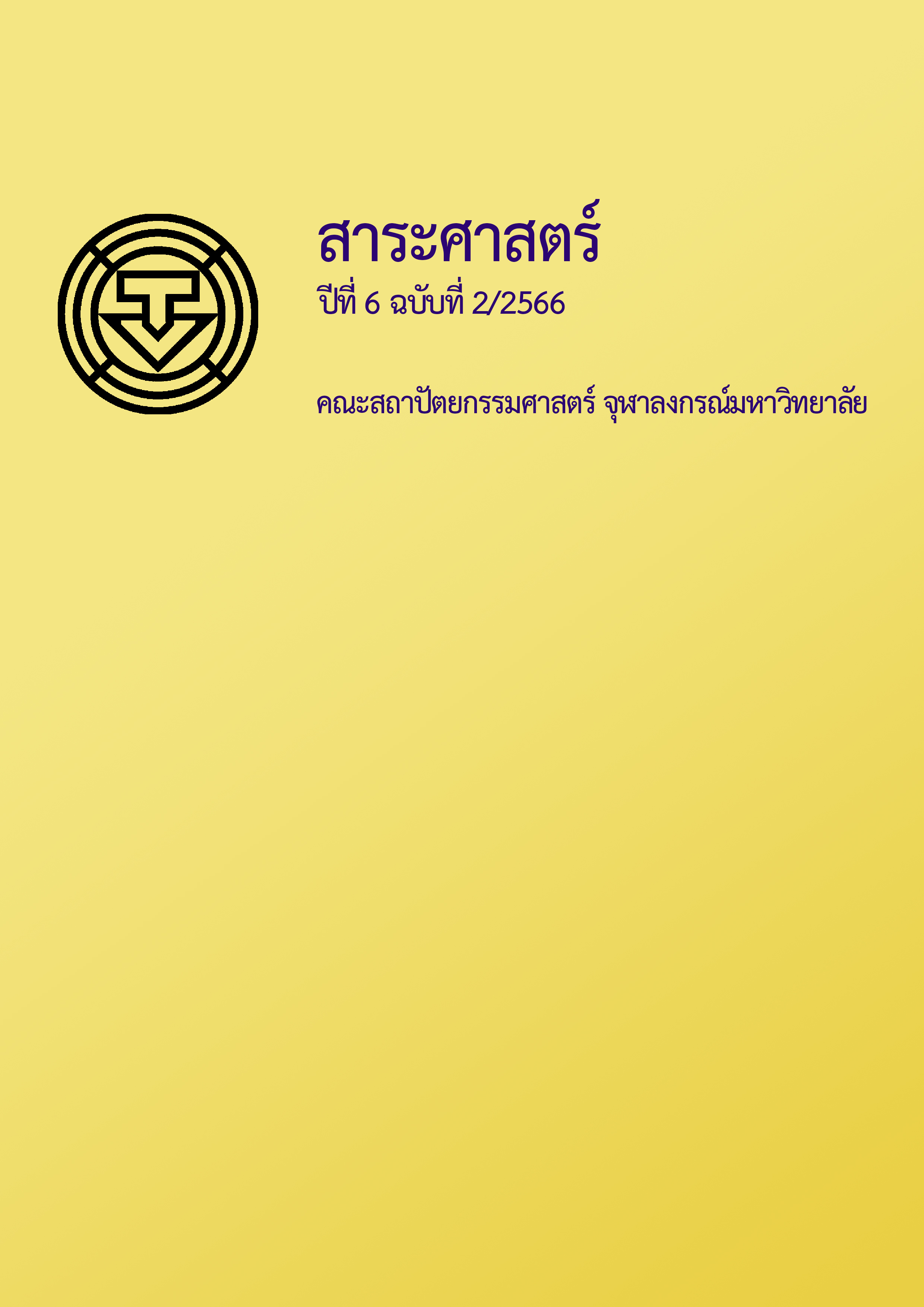ผลการศึกษารูปแบบสัณฐานเมืองและปัจจัยทางกายภาพที่มีอิทธิพลต่อพฤติกรรมการเลือกเส้นทางสัญจรทางเท้าในเขตกรุงเทพมหานคร
Main Article Content
บทคัดย่อ
งานวิจัยนี้มีวัตถุประสงค์เพื่อศึกษาความสัมพันธ์ระหว่างรูปแบบสัณฐานเมืองและสภาพแวดล้อมทางกายภาพที่มีอิทธิพลต่อพฤติกรรมการเลือกเส้นทางการสัญจรโดยใช้ชุดทฤษฎีเชิงสัณฐานวิทยาเพื่อศึกษาการเข้าถึงโครงข่ายการสัญจรของเมือง ที่เรียกว่า Space syntax (Hillier et al., 1993) โดยวิเคราะห์ร่วมกับ โปรแกรมจำลองการสัญจรทางเท้าที่ผู้วิจัยพัฒนาขึ้นเองโดยเรียกว่า Walk 3D Test เพื่อศึกษาพฤติกรรมการเลือกเส้นทางการสัญจรในโครงข่ายลักษณะต่าง ๆ ว่า "ค่าสนามทัศน์" ที่ดึงดูดให้ผู้สัญจรเลือกใช้เส้นทางการสัญจรตามทฤษฎี Space syntax นั้นเมื่อเกิดปัจจัยทางกายภาพนั้นจะส่งผลต่อการเปลี่ยนแปลงเส้นทางการสัญจรของผู้สัญจรหรือไม่รวมถึงมีการวิเคราะห์ร่วมกับแบบสอบถามเชิงทัศนคติต่อปัจจัยทางกายภาพที่อาจส่งผลต่อการเปลี่ยนแปลงการสัญจรในเส้นทางนั้น ๆ หรือไม่ เช่นกัน
จากผลการทดสอบสามารถอธิบายได้ว่าลักษณะโครงข่ายที่ซับซ้อนกลุ่มคนจะมีลักษณะการสัญจรที่คล้ายกันทั้งในรูปแบบที่มีสิ่งกีดขวางและไม่มีสิ่งกีดขวางในการสัญจรซึ่งแตกต่างจากลักษณะโครงข่ายที่ไม่ซับซ้อนและสามารถเข้าใจได้ง่าย ผู้สัญจรนั้นเลือกใช้เส้นทางที่สามารถนำไปสู่เป้าหมายได้เร็วที่สุด หรือมีลักษณะเส้นทางการสัญจรรูปแบบการกระจัดกระจายและเมื่อเกิดปัจจัยที่เป็นสิ่งกีดขวางบนทางสัญจรพบว่าผู้สัญจรเกิดทางเลือกที่หลากหลายในการสัญจรมากขึ้นเพื่อหลีกเลี่ยงการพบกับอุปสรรคในการสัญจร การมีเส้นนำทาง (way finding) นั้นสามารถช่วยผู้ใช้โครงข่ายที่ความซับซ้อนเข้าใจได้ง่ายขึ้น และมีการตัดสินใจที่รวดเร็วขึ้น รวมไปถึงสามารถนำพาให้ผู้สัญจรไปถึงเป้าหมายได้เร็วขึ้น การทดลองนี้แสดงให้เห็นว่าลักษณะสัณฐานเมืองนั้นมิได้เป็นตัวกำหนดเส้นทางที่ผู้คนนิยมเพียงเท่านั้น แต่สภาพแวดล้อมทางกายภาพรวมถึงลักษณะของผู้สัญจรนั้นมีอิทธิพลต่อทัศนคติและพฤติกรรมการเลือกเส้นทางการสัญจรทางเท้าด้วยเช่นกัน
Article Details
เอกสารอ้างอิง
ไขศรี ภักดิ์สุขเจริญ. (2548). วาทกรรมของเมืองผ่านโครงสร้างเชิงสัณฐาน. วารสารวิชาการคณะสถาปัตยกรรมศาสตร์, จุฬาลงกรณ์มหาวิทยาลัย 1-14.
ไขศรี ภักดิ์สุขเจริญ. (2550). กำแพงในซอย รั้วในใจ. คณะสถาปัตยกรรมศาสตร์ จุฬาลงกรณ์มหาวิทยาลัย.
ไขศรี ภักดิ์สุขเจริญ. (2551). ซอยลัดประหยัดพลังงาน พื้นที่ว่างสาธารณะขนาดเล็ก-พื้นที่ทางสังคมของชุมชนไทย. ภาควิชาการวางแผนภาคและเมือง คณะสถาปัตยกรรมศาสตร์ จุฬาลงกรณ์มหาวิทยาลัย.
ธิติมา กลางกําจัด. (2551). สนามทัศน์และรูปแบบการใช้พื้นที่ว่างสาธารณะของชุมชนเมือง : กรณีศึกษาชุมชนท่าทรายนนทบุรี [วิทยานิพนธ์ปริญญามหาบัณฑิตไม่ได้ตีพิมพ์]. จุฬาลงกรณ์มหาวิทยาลัย.
ว่าน ฉันทวิลาสวงศ์ และอดิศักดิ์ กันทะเมืองลี้. (2557). มหานครซอยตัน. Urban Design and Development Center.
ศูนย์ออกแบบและพัฒนาเมือง. (2562). Goodwalk score. http://goodwalk.org/
สิงหนาท แสงสีหนาท. (2563, มกราคม–มิถุนายน). ถิ่นที่วิวัฒน์จากคลองลัดถึงซอยลัด : ความเป็นเมืองที่ถูกปรับเปลี่ยนจากเมืองฐานน้ำสู่เมืองฐานบกของกรุงเทพ. หน้าจั่ว ว่าด้วยประวัติศาสตร์สถาปัตยกรรมและสถาปัตยกรรมไทย, 17(1), 92-125.
Carlo, Urmy. (2017). Wayfinding: A guide for urban trail networks. Emerald Network.
Hillier, B., & Hanson, J. (1984). The social logic of space. Cambridge University Press.
Hillier, B., Penn, A., Hanson, J., & Grajewski, T. (1993). Natural movement or configuration and attraction in urban pedestrian movement. Environmental and Planning B: Planning and Design, 20(1), 29-66.
Jacobs, J. (1961). The death and life of Great American cities. Random House.
Yamanae, T. (1973). Statistics: An introductory analysis (3rd ed). Harper & Row.


